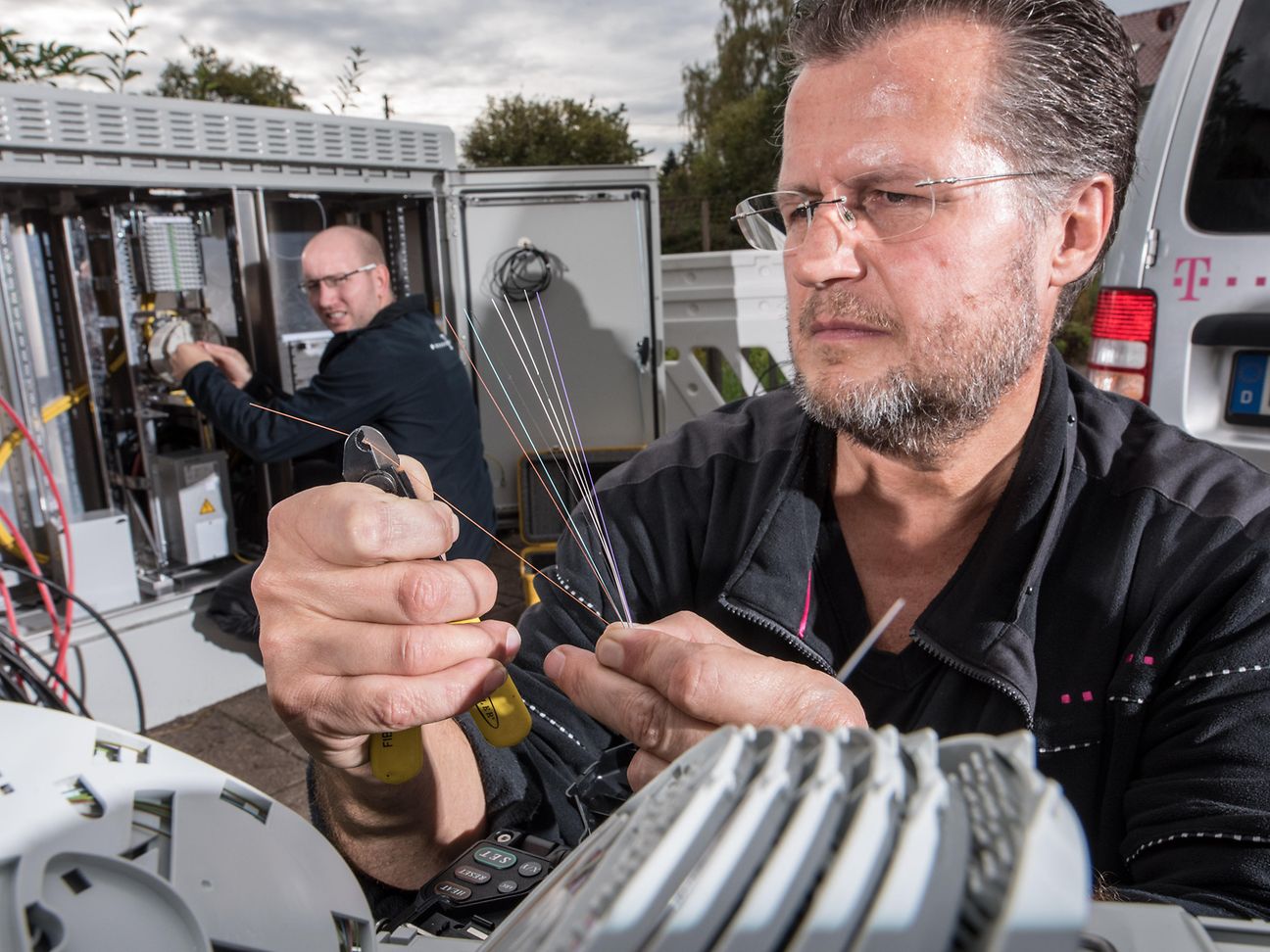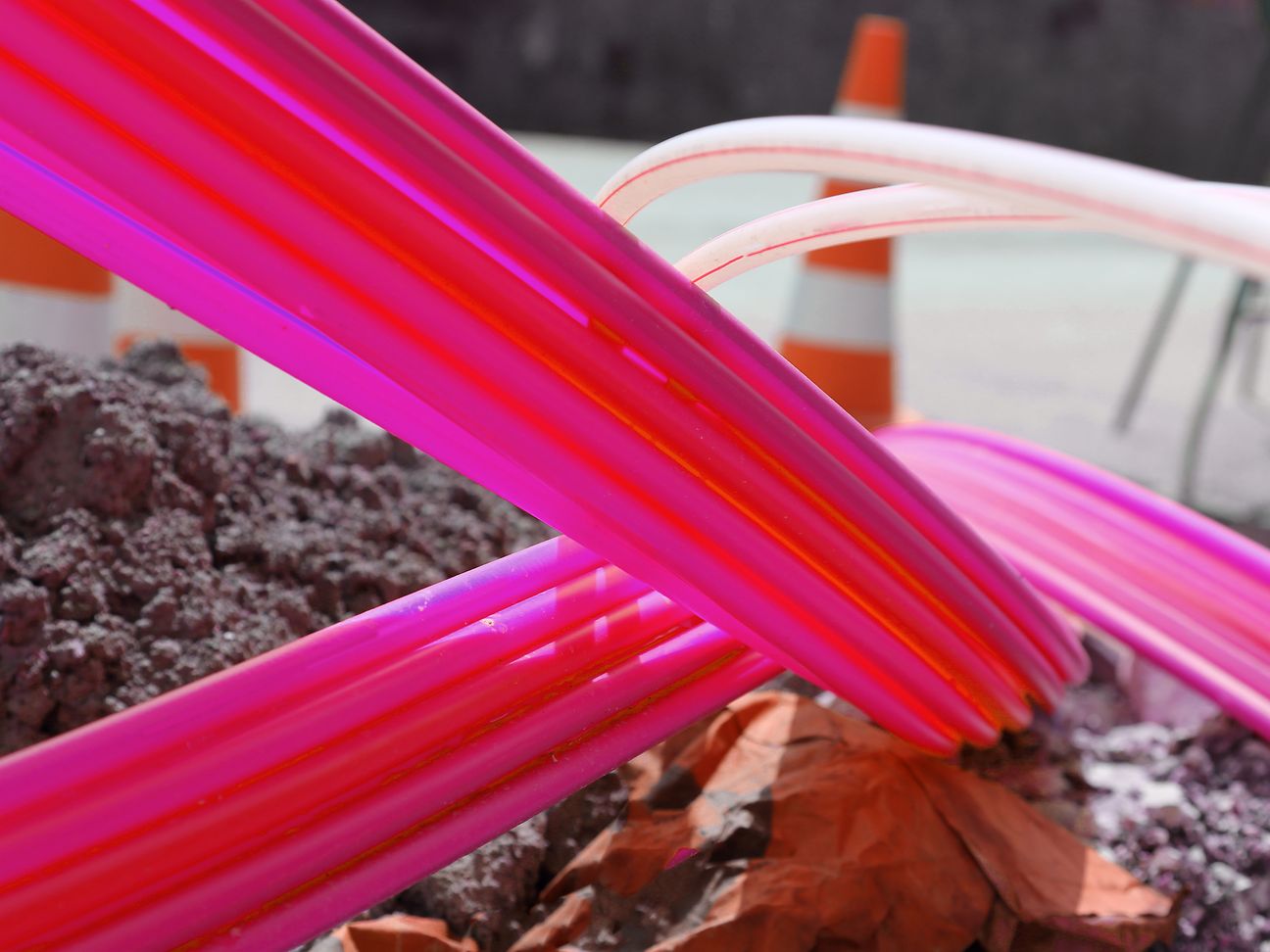Fiber-optic cable as the optical waveguide for fast internet
Fiber-optic cables are signal transmission cables. They consist of many individual optical fibers, which are made of quartz glass as the transmission medium and form an optical waveguide. These cables transmit light signals over large distances at the speed of light and with a huge data capacity.
Structure of a fiber-optic cable
The fiber-optic cable is made up of several individual optical fibers, which create a bundle. An individual fiber, which, at a diameter of 250 micrometers (µm) is as thin as a human hair, consists of a core, cladding, and a primary coating. These elements each perform a specific task to ensure that the fiber-optic cable works.
The fiber is made from quartz sand and is the transport channel for the optical light waves. The cladding ensures transmission of the light wave signals. The primary coating makes the optical fiber flexible and robust, thanks to its plastic properties. It therefore prevents the fiber from breaking when bent and from losing its function as an optical waveguide.
Optical waveguides differ according to design and use. Distinguishing features are, for example, the diameter of the fibers, the thickness of the coating, or the quality. The shape of the optical waveguide affects the quality of the transmission of optical light pulses. Optical waveguides can be classified as multi-mode or single-mode optical waveguides. The fiber core diameter of single-mode optical fibers is significantly smaller than that of multi-mode optical fibers. In general, single-mode optical waveguides are suitable for data transmission over long distances. Multi-mode optical waveguides are generally used for transmission over short distances in a data center.
Overview of fiber-optic cable types
- Pigtail: Short, exposed optical waveguide with optical connectors, intended exclusively for splicing
- Patch cable: Very flexible, connectors at both ends, low strain relief, equipped with adapter for different connectors
- Internal cable: Good strain relief, can be used flexibly in the climb section or floor wiring
- External cable: Robust and weather-resistant with protective coating
- Universal cable: Can be laid inside or outside, in pipes or shafts
In addition, the fiber-optic cables can be classified according to the type of coating. We speak of tight-buffered, loose-tubed, compact and filled or unfilled fiber-optic cables. The relevant criterion for this distinction is the positioning of the optical waveguide in the cable and the type of the surrounding sleeve.
There are different international and national standards for fiber-optic cables:
- ITU-T G.651 to G.657
- ISO/IEC 11801 and 24702 and IEC 60793
- DIN VDE 0888
Deutsche Telekom uses fiber-optic cables with up to 192 individual optical fibers. On the global market, fiber-optic cables with up to more than 500 fibers are used for different purposes.
How is data transmitted with a fiber-optic cable?
Scientists have been dealing with the transfer of signals using light since the 19th century. In the 1950s, light waves were used in medical treatments for the first time. To this day, fiber-optic technology has been improving constantly. In the meantime, increasingly large data volumes can be transported over increasingly long distances at higher speeds. As with copper cables, attenuation is a challenge when transmitting optical signals through optical fibers. The longer a fiber-optic cable is, the less light can travel from one end to the other. Over long distances, the light loss is compensated for by repeaters that reinforce the optical signals.
In a fiber-optic cable, data is transferred via light. The optical signals that are generated by laser diodes travel through the fibers. The signals are transmitted at the speed of light. The apparently complex physical process can actually be explained very simply. The light waves propagate in the optical fiber.
The optical fiber consists of a core and cladding. The properties of the outer protective coating prevent signals from being able to exit the core. The reason for this is the different refractive index of the core and cladding, which ensures that the moving light waves do not escape through the cladding and become lost for the signal transmission. Instead, they are able to make their way through the fiber and cover long distances. This is possible due to a procedure called doping. Here, very small quantities of additional foreign atoms are added to the material of the cladding. For an optical waveguide, for example, this could be germanium or phosphorus. These mix together with the quartz sand and give the cladding its refractive properties.
Optical waveguides have become an indispensable component for communication networks across the globe and are used in communications engineering, telecommunications, and many other areas. The technology is also familiar from medicine, from endoscopes and microscopes, laser beams or lights on devices, buildings, or decorative elements. In addition, optical waveguides are often used in optical measurement devices.
Laying fiber-optic cables
In addition to underground installation and above-ground installation using masts, Deutsche Telekom primarily uses compressed air to blow its outdoor fiber-optic cables into small empty pipes (speed pipes), which have previously been laid in the ground or in jacket tubes.
The speed pipes have an internal diameter of four to eight millimeters and are often laid in a pipe network of up to 22 pipes. The fiber-optic cables (diameter 2.3 millimeters to 6.5 millimeters) are blown into these speed pipes by up to 2000 meters at a stretch using special compressed air compressors. Depending on the cable route and type, the fiber-optic cable on the compressed air cushion is driven forward over a distance of up to 100 meters within a minute with the additional aid of a mechanical propulsion device on the compressor. The propulsion device and air cushion act like a conveyor belt within the pipe. The fiber-optic cable is either blown in directly from the Deutsche Telekom operating site or from central distributors on the road (outdoor housing, sleeve, or manhole) toward the customer.
The fiber optic routes often run along public walkways or roads in different network sections over at times large distances. In areas without existing empty pipes and with old copper technology, significant expenditure is involved in the construction of new fiber-optic routes in the public area.
To ensure that the individual optical fibers in the cable can be connected in the respective network elements, such as the home connection, underground cable sleeves, or a distributor station, the ends of the fibers of the optical waveguide cable are welded together end-to-end through simultaneous joining with an electric arc.
This process is called splicing. The molten glass joins together and solidifies after cooling. A splicing protector must be provided at this location to protect against mechanical impacts and environmental influences. Precise splicing tools are used for fiber-optic splicing which leave only minimal attenuation at the splicing site.
In the past, fiber-optic cables were almost only ever laid between operating sites in long-distance traffic. In the meantime, however, fiber-optic cables are increasingly laid from the operating sites through the home connection to the customer’s apartment. This build-out method is called FTTH (Fiber to the Home). Other common connection architectures for optical fibers include FTTB (Fiber to the Building) and FTTC (Fiber to the Curb). In addition to the huge potential of consumers, it will in future also be possible to connect business customers and mobile communication sites almost exclusively with fiber-optic cables.
Difference between fiber-optic cable and copper cable
With a fiber-optic cable, many optical waveguides are bundled together. They take on the role of a transmission medium in a network. The transmission is implemented through photons, i.e., optical light signals. This is the main difference compared to data transmission via copper cables. There, electrons emit the pulses to transfer electrical signals.
The key advantage of fiber-optic technology is that it enables very high transmission rates. In a fiber-optic communication network, bandwidths of up to several Terabit/s (1,000,000 Mbit/s) can be transported via an optical fiber in the core and long-distance network and up to several Gigabit /s (1,000 Mbit/s) in the access network to the customer, meaning that the data can be transmitted both very quickly and efficiently.
In addition to the speed, fiber-optic technology also scores in terms of reliability. Electromagnetic incidents do not influence data transmission via fiber-optic cables. This advantage is significant because, in the age of digital transformation and increasing numbers of online applications running in parallel, a continuously high transmission capacity meets all the requirements of discerning internet users.

